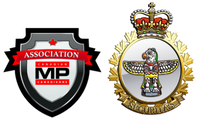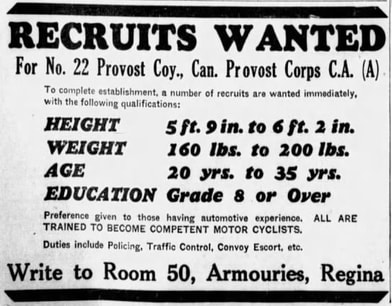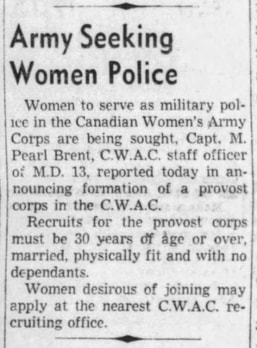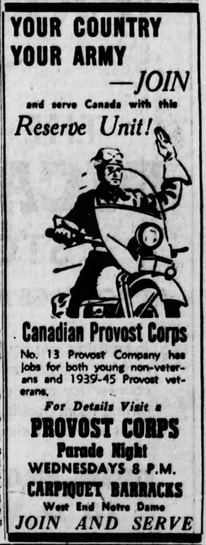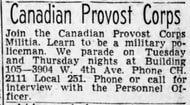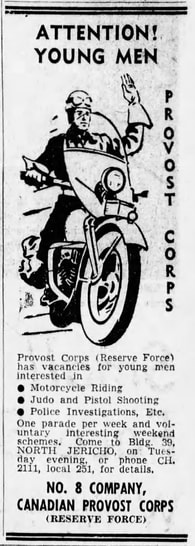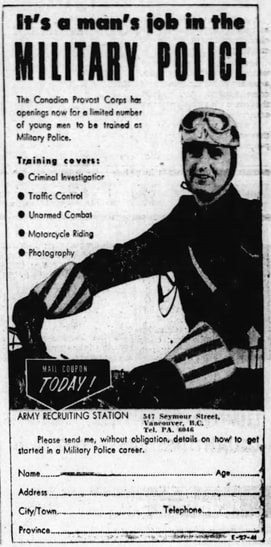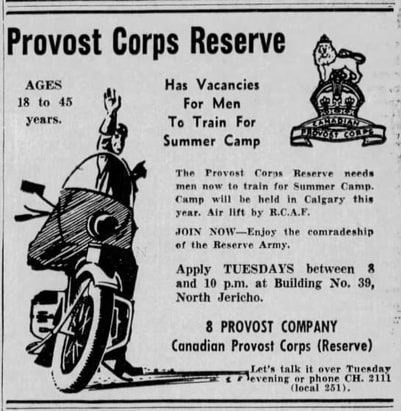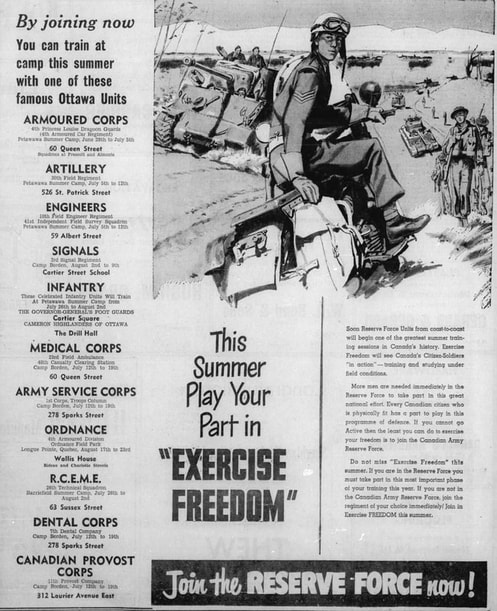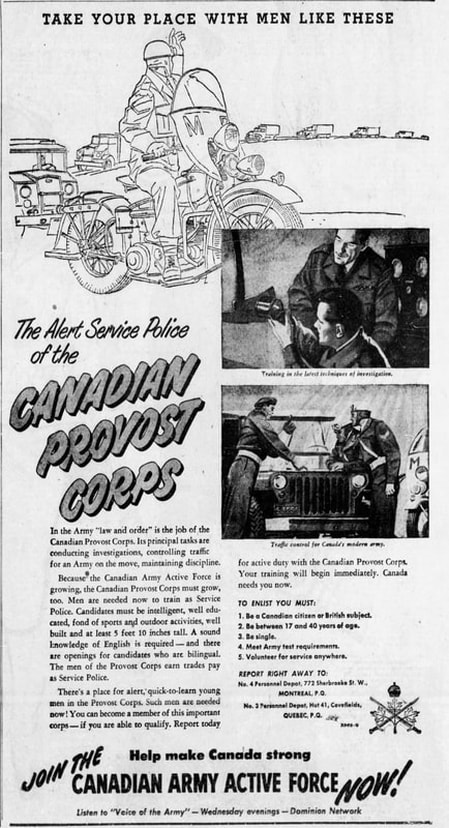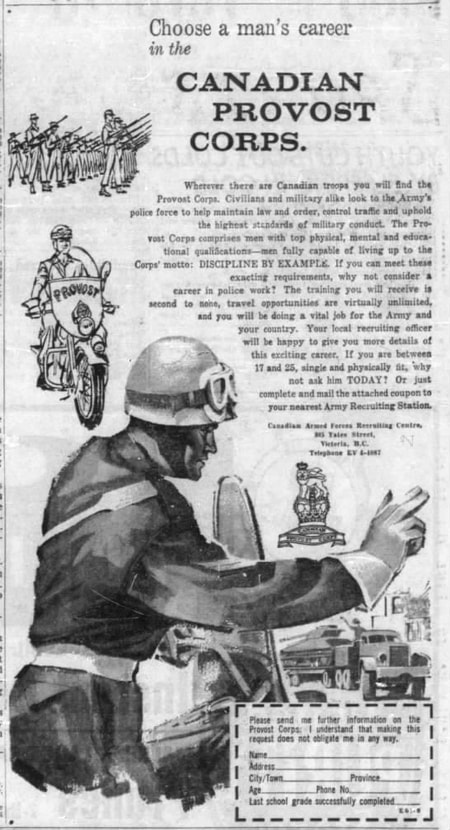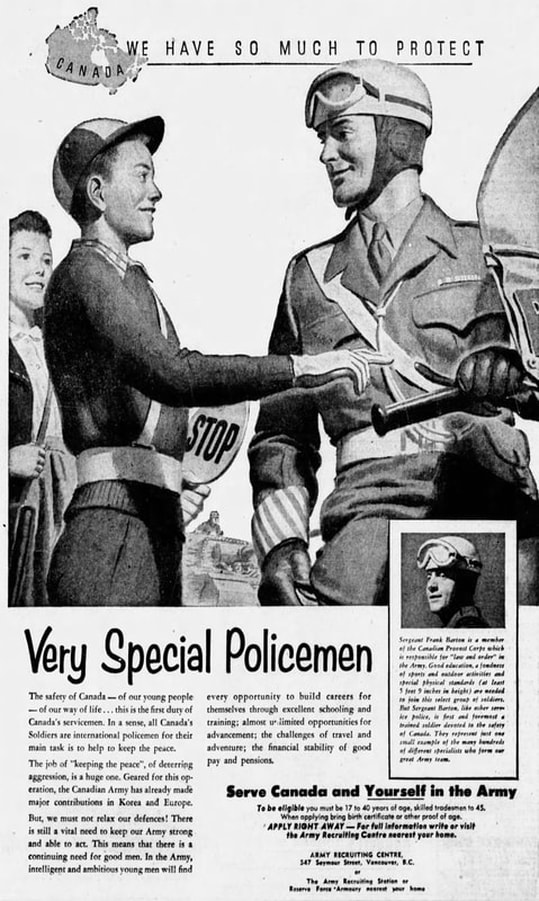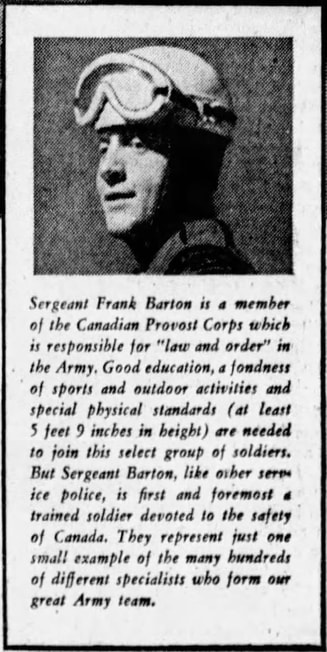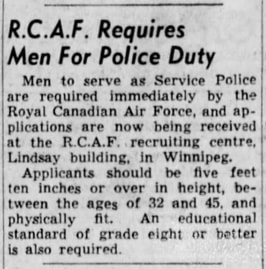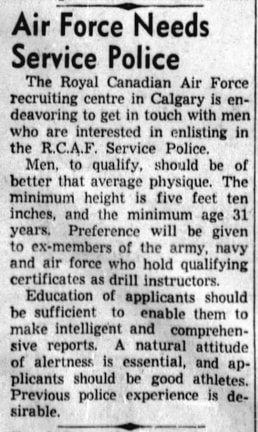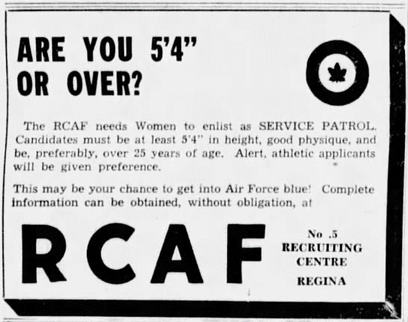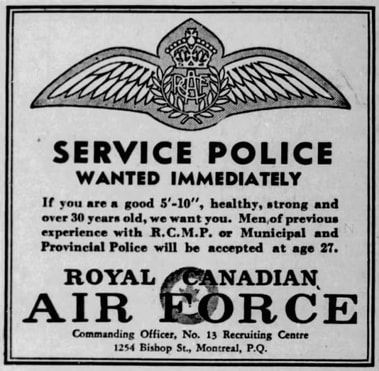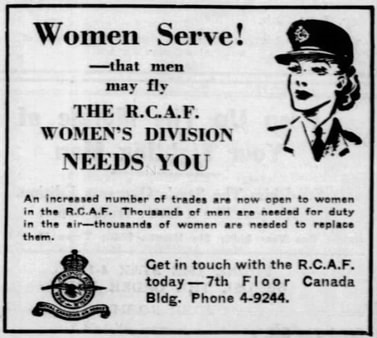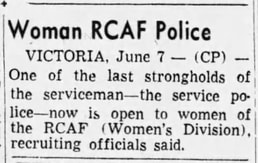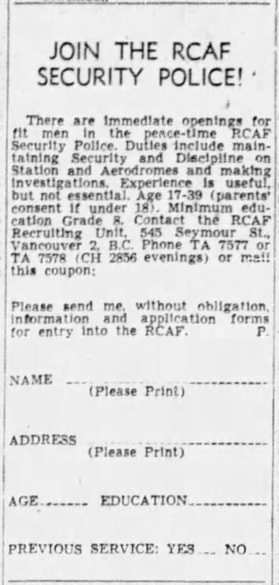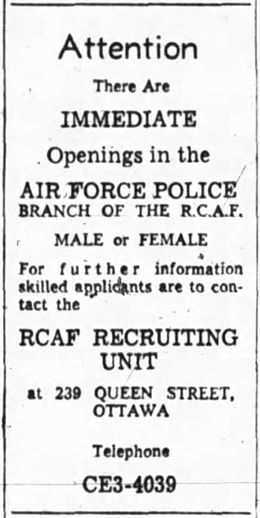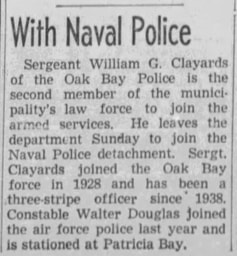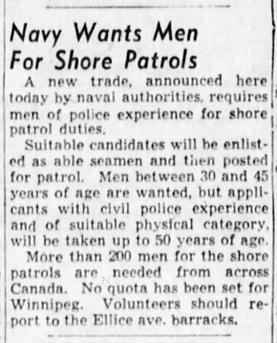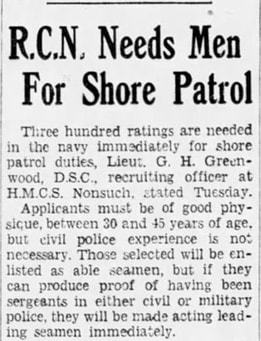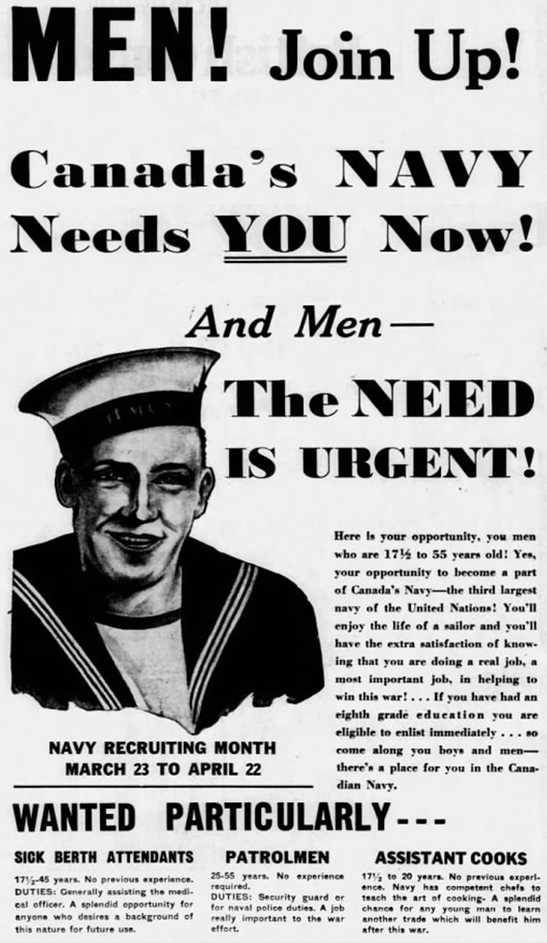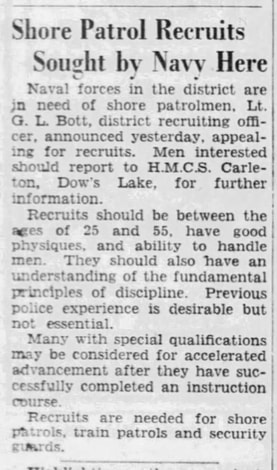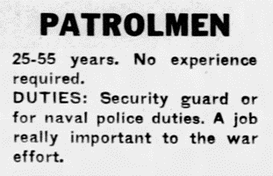Looking Back: Service Police Recruiting Ads
By Lieutenant-Colonel Paul Thobo-Carlsen (Retired), CMPA Director of History & Heritage.
In the Internet era it is easy to forget that newspapers were once a primary means of reaching potential military recruits. A scan of Canadian newspapers from 1940 to 1968 reveals a surprisingly large number of ads seeking service police members for the three pre-unification armed services.
Canadian Provost Corps
|
The Canadian Provost Corps (CProC) was the most prolific newspaper advertiser of the service policing organizations, with many of its recruiting ads featuring artwork depicting Provost members in action—most often mounted on a motorcycle. The following is a selection of wartime and postwar CProC recruiting ads.
During the Second World War CProC ads frequently focused on recruiting for a specific Provost Company raised in the city or Province serviced by the newspaper. The add to the left is typical of this. Interestingly, this notice is at odds with most other CProC recruiting ads of the period which stated a minimum height requirement but no maximum, and listed a minimum age of 25 and education level of at least grade 9. Some CProC ads also mentioned desirable traits for Provost candidates such as "strict sobriety," having "a high degree of intelligence," and being "calm and decisive" and "of good character." Previous police experience was sometimes listed as being preferable, though not absolutely essential.
|
(Source: Saskatoon Star-Phoenix, Saturday 27 September 1941, page 2)
|
|
In August 1942, the Canadian Woman Army Corps (CWAC) was authorized to have its own Provost organization to help ensure discipline within its ranks.[1] Initial notices mentioned an age range of 25-35 for CWAC Provost candidates, but latter ads—such as the one to the right—upped the minimum age to 30. While their was no minimum height set for this trade, some ads noted that candidates needed to be of "good physical build." Some articles listed other desirable characteristics like "suitable temperament," "intelligence," "tact and judgment," and "firmness and the ability to make quick decisions." These military policewomen attended a 30-day course which included training on drill, military law, traffic control and unarmed self-defence (based on judo).[2] CWAC Provost also received revolver training in case of emergencies, although they were not normally armed while on duty. In August 1944, CAWC Provost training was moved from Winnipeg, Manitoba to the main "A32" CProC Training Centre in Camp Borden, Ontario.[3]
(Source: Calgary Herald, Wednesday 3 March 1943, page 10)
|
Postwar CProC ads in the late 1940s and 1950 often featured appeals to patriotism, camaraderie and adventure. Some, like the one on the far right below, had clearly macho overtones by today's standards.
(Sources: Left to right - Winnipeg Tribune, Thursday 2 December 1948, page 19; Leader-Post [Regina], Monday 4 January 1951, page 18--upper ad; Vancouver Sun, Saturday 28 September 1957, page 31--lower ad; Vancouver Sun, Saturday 18 April 1953, page 18; Vancouver Sun, Monday 24 February 1958, page 10)
The allure of the dashing motorcycle-mounted military policeman figured prominently in CProC active force and reserve ads into the 1960s, and the high production value of some such ads no doubt convinced many young men that the CProC was the place for them.
|
(Sources: Above - Vancouver Sunday Sun, Saturday 3 April 1954, page 16. Right - Ottawa Citizen, Wednesday 4 June 1952, page 12. Below, clockwise from left - The Gazette [Montreal], Wednesday 28 March 1951, page 13; The Times-Colonist [Victoria,] Thursday 1 March 1962, page 11; and The Province [Vancouver], Wednesday 2 June 1954, page 22)
|
Royal Canadian Air Force - Service Police, Security Police and Air Force Police
|
The air force also widely leveraged newspapers to attract its police recruits. Wartime recruiting pitches tended to be to be simple write-ups, sometime included in larger articles about RCAF activities or general recruiting campaigns. RCAF Service Policemen initially had to be over 30 years of age, but later ads stated that candidates with previous police experience could enlist at 27. Interestingly, the air force set it's service police height requirement an inch taller than that required for Army provost recruits.
|
(Sources: Left to right - Winnipeg Tribune, Thursday 27 Mar 1941, page 15; Calgary Herald, Monday 31 Mar 1941; and Edmonton Journal,Wednesday 7 August 1940, page 10)
|
|
RCAF Service Police recruiting ads with a bit more visual appeal occasionally appeared during the war, such as the ones shown at the right.
In July 1942, beating the Army's CWAC Provosts by a month, the first policewomen of the RCAF Women's Division started their work in maintaining discipline within this growing organization. While they shared the "SP" acronym (and armband) with their male counterparts, for these specially trained airwomen it stood for "Service Patrol." Ostensibly, the word "patrol" was substituted for "police" to suggest a softer image in the women's service. Regardless, these new policewomen were required to undergo a four-week training course at the RCMP Barracks in Rockcliffe (Ottawa), Ontario, which included life saving (first aid), unarmed self-defense (judo) and revolver shooting. Few targeted ads can be found for the Women's Division SP, suggesting that generic recruiting ads were generally sufficient to attract enough recruits from which to select a suitable number of candidates with the temperament and traits to be successful service policewomen.
When the post-war RCAF opened the Women's Division to full-fledged Service Police duty in 1951 some articles were also published to help attract suitable candidates.
(Sources: Above - The Leader-Post [Regina], Monday 7 June 1943, page 6.. Upper right - The Gazette [Montreal], Tuesday 15 December 1942, page 17. Centre right - Windsor Star, Saturday 26 June 1943, page 7). Lower right - Vancouver Sun, Saturday 14 September 1951, page 35.
|
Despite the rapid re-building of the RCAF starting in 1951, relatively few distinct ads for RCAF Service Police can be found for the early 1950s period. The majority of RCAF ads during this time tended to be very generic, and those that listed trades in need of recruits rarely listed SP. This suggests that walk-in recruiting and the re-enrollment of trained wartime SPs largely took care of the RCAF's police staffing needs. One exception to this rule (below, left) is an ad that is also unique because it uses the "Security Police" trade name that was adopted very briefly from 1952 to 1955 before being replaced by the better know "Air Force Police" (AFP) name. Another ad from the late 1950s (below, center) is unique in that it was from the first recruiting campaign to seek both male and female AFP candidates together.
Beginning in 1964, during a period of swift AFP trade enlargement to support nuclear weapon security operations in both Europe and Canada, many newspaper ads were published to recruit Air Force Police, like the example below, right.
Royal Canadian Navy - Naval Patrol and Shore Patrol
|
Early in the war the RCN formed several Naval Patrol units (sometimes informally called 'Naval Police') under the command of local Naval Provost Marshals. While no specific recruiting ads have so far been found for these early organizations, period newspapers did make reference to them (example, right).
In January 1943, the Navy decided to abandon the Naval Patrol branch and replace it with a system of shore patrols raised from ship's companies. This quickly proved problematic and the Navy soon began recruiting men again for permanent Shore Patrol duties. By the Fall of 1943 the Naval Shore Patrol Service (NSPS) become a distinct branch of the RCN like the Naval Patrol before it.[4] The ratings within the NSPS collectively became know as patrolmen.
Strong mature men, preferably with previous civilian or military policing experience, were the target audience for wartime Shore Patrol recruiting efforts.
|
Victoria Daily Times, Friday 14 February 1941)
|
Most Shore Patrol recruiting ads tended to be without artistic embellishment, and recruiting info was often embedded in general news articles about a particular naval unit. However, a few ads were designed to be more visually appealing (below, left).
The RCN eventually created it own wartime women's service police capability to help ensure discipline within the Women's Royal Canadian Navy Service (WRCNS), popularly known as the "Wrens." The WRCNS "Ships Police" trade comprised a small number of servicewomen in the following ratings: Regulating Wren; Leading Regulating Wren; Wren Regulating Petty Officer; and Wren Master-at-Arms.[5] No specific recruiting ads for these Wren Regulators have yet been found.
RCN shore patrol activities were sharply reduced and re-organized soon after the war--once again becoming a secondary duty for members of ship's companies. The Navy did recreated a standing "Naval Shore Patrol" organization from 1952 to 1960, and RCN Regulating Petty Officers and Masters-at-Arms continued to hold disciplinary and quasi-police responsibilities until 1960 when that rating was merged into a new Boatswain trade.
A surprisingly rich overview of Canada's pre-unification service policing organizations can be gleaned from a review of the many recruiting advertisements that were published in newspapers across the country from 1940 to 1967. While these ads may lack the slick production value of the Canadian Armed Forces' current slate of web-based interactive recruiting tools, they proved up to the task of ensuring a steady stream of qualified recruits to the various service police schools throughout the Second World War, the Korean War, and well into the Cold War.
----------
Notes:
1. "C.W.A.C. to Have Own Provost Corps," The Leader-Post (Regina, Saskatchewan), Monday 10 August 1942, page 3.
2. "New Corps of Policewomen Take Over Duties in CWAC Camps," The Province (Vancouver, British-Columbia), Tuesday 13 October 1942, page 10.
3. "Provost Course Opens for C.W.A.C's," Calgary Herald (Calgary, Alberta), Friday 11 August 1944, page 6.
4. "Shore Patrol," Winnipeg Tribune (Winnipeg, Manitoba), Thursday 18 November 1943, page 20 and Lieutenant (Navy) M. Baker, "Policing the RCN," in On Guard for Thee: The Silver Anniversary of the Security Branch (JOSTENS: Winnipeg MB, 1993), page 5.
5. Canada Gazette, 1867-1946 (Dominion of Canada), volume 78, number 53, 30 December 1944, Naval General Orders regarding amendments to the Women's Royal Canadian Naval Service Regulations, pp. 5432-5433.
Notes:
1. "C.W.A.C. to Have Own Provost Corps," The Leader-Post (Regina, Saskatchewan), Monday 10 August 1942, page 3.
2. "New Corps of Policewomen Take Over Duties in CWAC Camps," The Province (Vancouver, British-Columbia), Tuesday 13 October 1942, page 10.
3. "Provost Course Opens for C.W.A.C's," Calgary Herald (Calgary, Alberta), Friday 11 August 1944, page 6.
4. "Shore Patrol," Winnipeg Tribune (Winnipeg, Manitoba), Thursday 18 November 1943, page 20 and Lieutenant (Navy) M. Baker, "Policing the RCN," in On Guard for Thee: The Silver Anniversary of the Security Branch (JOSTENS: Winnipeg MB, 1993), page 5.
5. Canada Gazette, 1867-1946 (Dominion of Canada), volume 78, number 53, 30 December 1944, Naval General Orders regarding amendments to the Women's Royal Canadian Naval Service Regulations, pp. 5432-5433.
